Yinsong Liu
TACO: Think-Answer Consistency for Optimized Long-Chain Reasoning and Efficient Data Learning via Reinforcement Learning in LVLMs
May 27, 2025Abstract:DeepSeek R1 has significantly advanced complex reasoning for large language models (LLMs). While recent methods have attempted to replicate R1's reasoning capabilities in multimodal settings, they face limitations, including inconsistencies between reasoning and final answers, model instability and crashes during long-chain exploration, and low data learning efficiency. To address these challenges, we propose TACO, a novel reinforcement learning algorithm for visual reasoning. Building on Generalized Reinforcement Policy Optimization (GRPO), TACO introduces Think-Answer Consistency, which tightly couples reasoning with answer consistency to ensure answers are grounded in thoughtful reasoning. We also introduce the Rollback Resample Strategy, which adaptively removes problematic samples and reintroduces them to the sampler, enabling stable long-chain exploration and future learning opportunities. Additionally, TACO employs an adaptive learning schedule that focuses on moderate difficulty samples to optimize data efficiency. Furthermore, we propose the Test-Time-Resolution-Scaling scheme to address performance degradation due to varying resolutions during reasoning while balancing computational overhead. Extensive experiments on in-distribution and out-of-distribution benchmarks for REC and VQA tasks show that fine-tuning LVLMs leads to significant performance improvements.
HRVDA: High-Resolution Visual Document Assistant
Apr 10, 2024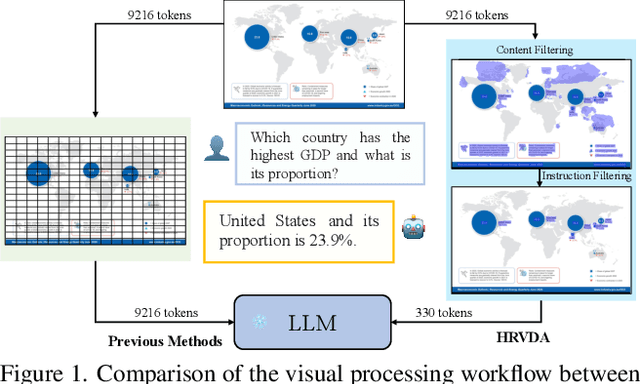
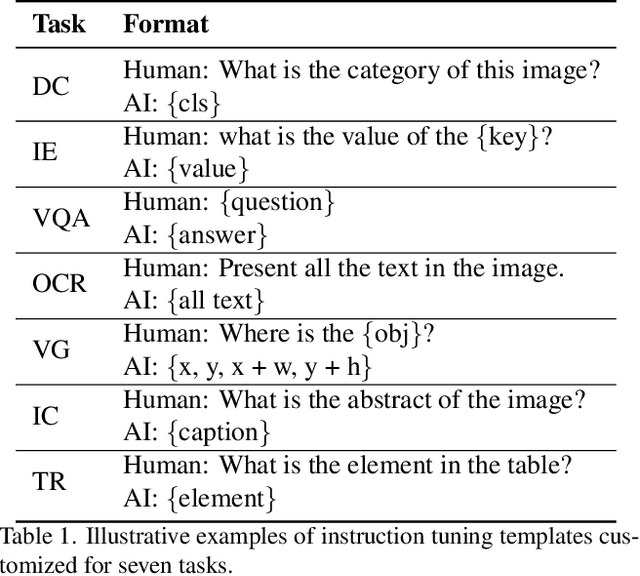
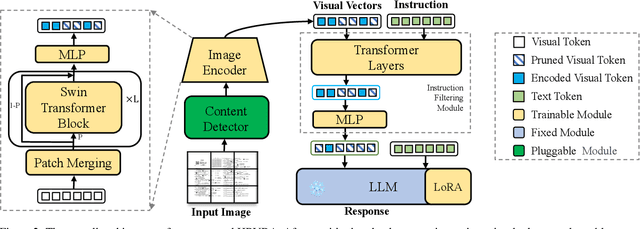

Abstract:Leveraging vast training data, multimodal large language models (MLLMs) have demonstrated formidable general visual comprehension capabilities and achieved remarkable performance across various tasks. However, their performance in visual document understanding still leaves much room for improvement. This discrepancy is primarily attributed to the fact that visual document understanding is a fine-grained prediction task. In natural scenes, MLLMs typically use low-resolution images, leading to a substantial loss of visual information. Furthermore, general-purpose MLLMs do not excel in handling document-oriented instructions. In this paper, we propose a High-Resolution Visual Document Assistant (HRVDA), which bridges the gap between MLLMs and visual document understanding. This model employs a content filtering mechanism and an instruction filtering module to separately filter out the content-agnostic visual tokens and instruction-agnostic visual tokens, thereby achieving efficient model training and inference for high-resolution images. In addition, we construct a document-oriented visual instruction tuning dataset and apply a multi-stage training strategy to enhance the model's document modeling capabilities. Extensive experiments demonstrate that our model achieves state-of-the-art performance across multiple document understanding datasets, while maintaining training efficiency and inference speed comparable to low-resolution models.
Enhancing Visual Document Understanding with Contrastive Learning in Large Visual-Language Models
Feb 29, 2024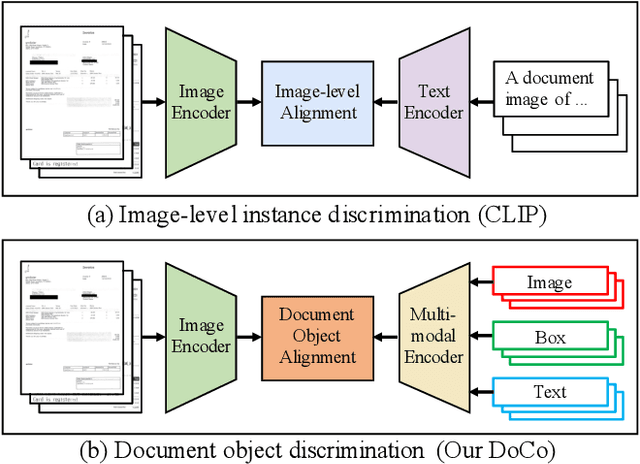
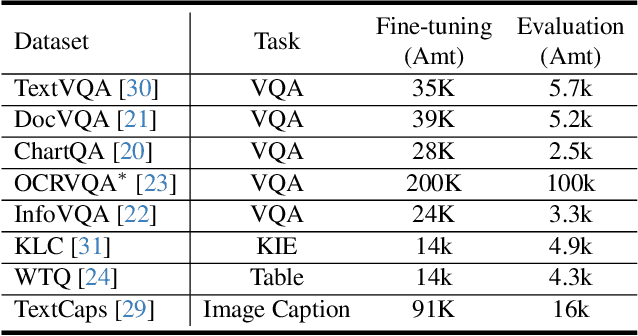
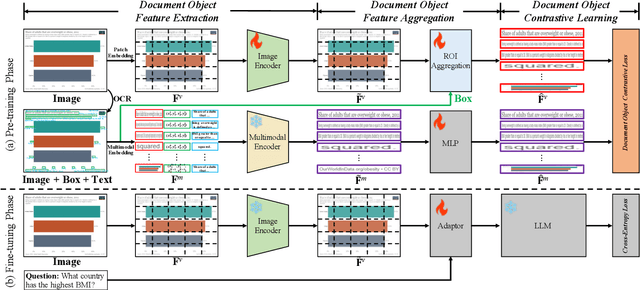

Abstract:Recently, the advent of Large Visual-Language Models (LVLMs) has received increasing attention across various domains, particularly in the field of visual document understanding (VDU). Different from conventional vision-language tasks, VDU is specifically concerned with text-rich scenarios containing abundant document elements. Nevertheless, the importance of fine-grained features remains largely unexplored within the community of LVLMs, leading to suboptimal performance in text-rich scenarios. In this paper, we abbreviate it as the fine-grained feature collapse issue. With the aim of filling this gap, we propose a contrastive learning framework, termed Document Object COntrastive learning (DoCo), specifically tailored for the downstream tasks of VDU. DoCo leverages an auxiliary multimodal encoder to obtain the features of document objects and align them to the visual features generated by the vision encoder of LVLM, which enhances visual representation in text-rich scenarios. It can represent that the contrastive learning between the visual holistic representations and the multimodal fine-grained features of document objects can assist the vision encoder in acquiring more effective visual cues, thereby enhancing the comprehension of text-rich documents in LVLMs. We also demonstrate that the proposed DoCo serves as a plug-and-play pre-training method, which can be employed in the pre-training of various LVLMs without inducing any increase in computational complexity during the inference process. Extensive experimental results on multiple benchmarks of VDU reveal that LVLMs equipped with our proposed DoCo can achieve superior performance and mitigate the gap between VDU and generic vision-language tasks.
Attention Where It Matters: Rethinking Visual Document Understanding with Selective Region Concentration
Sep 03, 2023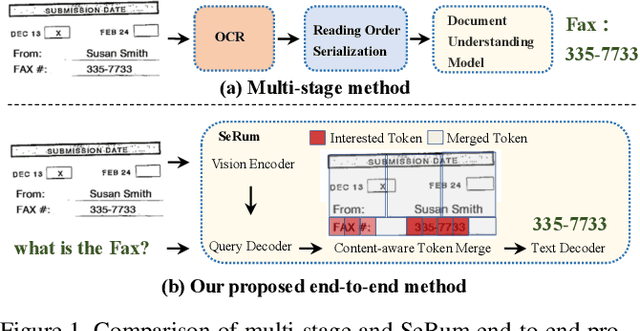


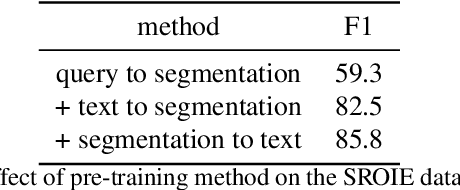
Abstract:We propose a novel end-to-end document understanding model called SeRum (SElective Region Understanding Model) for extracting meaningful information from document images, including document analysis, retrieval, and office automation. Unlike state-of-the-art approaches that rely on multi-stage technical schemes and are computationally expensive, SeRum converts document image understanding and recognition tasks into a local decoding process of the visual tokens of interest, using a content-aware token merge module. This mechanism enables the model to pay more attention to regions of interest generated by the query decoder, improving the model's effectiveness and speeding up the decoding speed of the generative scheme. We also designed several pre-training tasks to enhance the understanding and local awareness of the model. Experimental results demonstrate that SeRum achieves state-of-the-art performance on document understanding tasks and competitive results on text spotting tasks. SeRum represents a substantial advancement towards enabling efficient and effective end-to-end document understanding.
Grab What You Need: Rethinking Complex Table Structure Recognition with Flexible Components Deliberation
Mar 16, 2023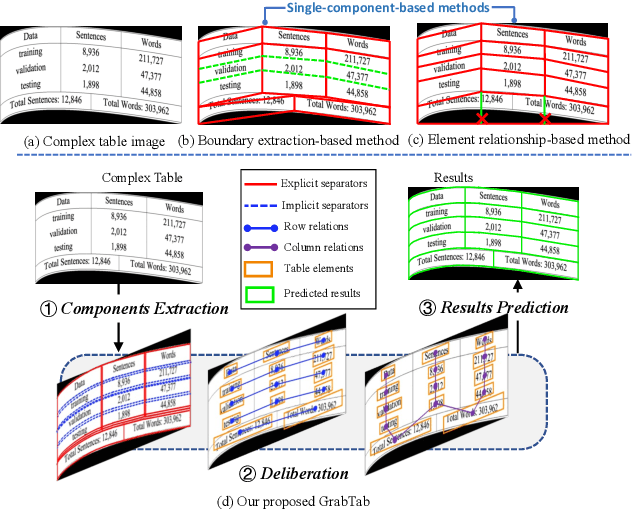


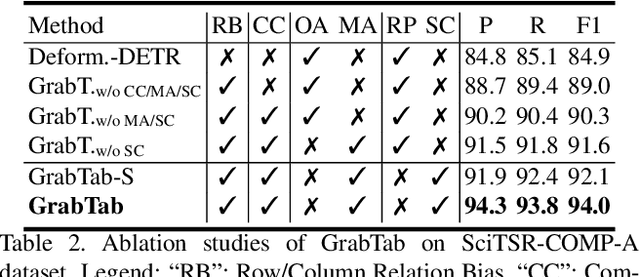
Abstract:Recently, Table Structure Recognition (TSR) task, aiming at identifying table structure into machine readable formats, has received increasing interest in the community. While impressive success, most single table component-based methods can not perform well on unregularized table cases distracted by not only complicated inner structure but also exterior capture distortion. In this paper, we raise it as Complex TSR problem, where the performance degeneration of existing methods is attributable to their inefficient component usage and redundant post-processing. To mitigate it, we shift our perspective from table component extraction towards the efficient multiple components leverage, which awaits further exploration in the field. Specifically, we propose a seminal method, termed GrabTab, equipped with newly proposed Component Deliberator. Thanks to its progressive deliberation mechanism, our GrabTab can flexibly accommodate to most complex tables with reasonable components selected but without complicated post-processing involved. Quantitative experimental results on public benchmarks demonstrate that our method significantly outperforms the state-of-the-arts, especially under more challenging scenes.
GMN: Generative Multi-modal Network for Practical Document Information Extraction
Jul 11, 2022


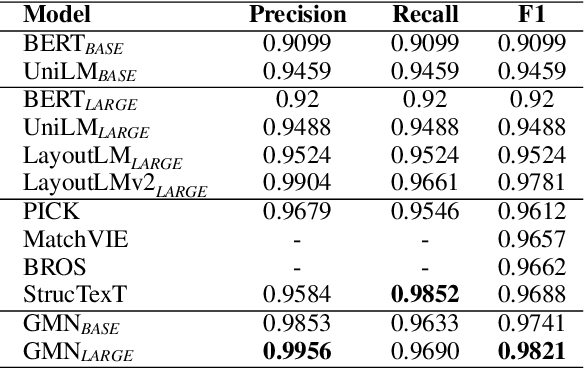
Abstract:Document Information Extraction (DIE) has attracted increasing attention due to its various advanced applications in the real world. Although recent literature has already achieved competitive results, these approaches usually fail when dealing with complex documents with noisy OCR results or mutative layouts. This paper proposes Generative Multi-modal Network (GMN) for real-world scenarios to address these problems, which is a robust multi-modal generation method without predefined label categories. With the carefully designed spatial encoder and modal-aware mask module, GMN can deal with complex documents that are hard to serialized into sequential order. Moreover, GMN tolerates errors in OCR results and requires no character-level annotation, which is vital because fine-grained annotation of numerous documents is laborious and even requires annotators with specialized domain knowledge. Extensive experiments show that GMN achieves new state-of-the-art performance on several public DIE datasets and surpasses other methods by a large margin, especially in realistic scenes.
Relational Representation Learning in Visually-Rich Documents
May 05, 2022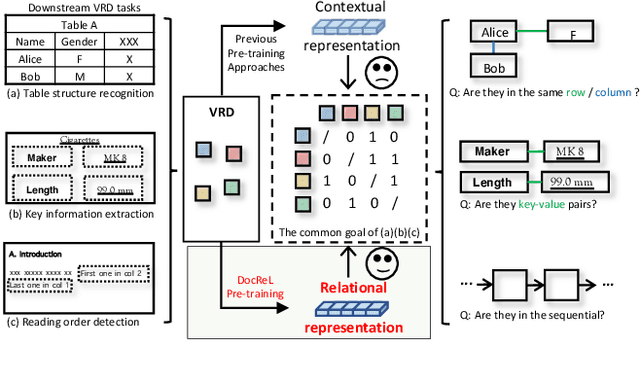
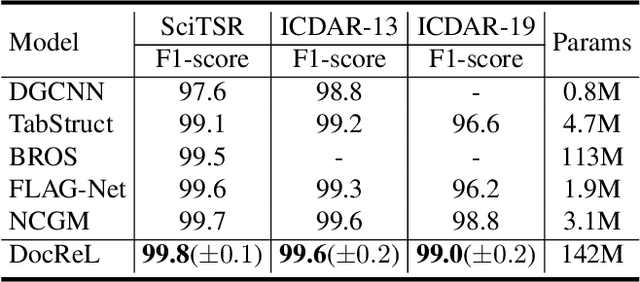

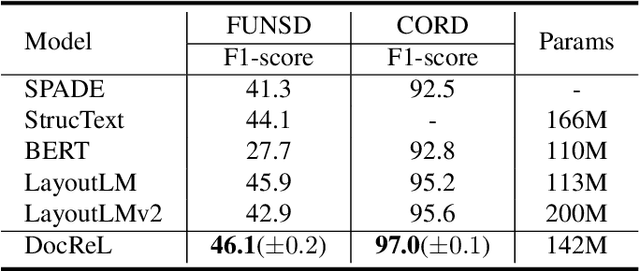
Abstract:Relational understanding is critical for a number of visually-rich documents (VRDs) understanding tasks. Through multi-modal pre-training, recent studies provide comprehensive contextual representations and exploit them as prior knowledge for downstream tasks. In spite of their impressive results, we observe that the widespread relational hints (e.g., relation of key/value fields on receipts) built upon contextual knowledge are not excavated yet. To mitigate this gap, we propose DocReL, a Document Relational Representation Learning framework. The major challenge of DocReL roots in the variety of relations. From the simplest pairwise relation to the complex global structure, it is infeasible to conduct supervised training due to the definition of relation varies and even conflicts in different tasks. To deal with the unpredictable definition of relations, we propose a novel contrastive learning task named Relational Consistency Modeling (RCM), which harnesses the fact that existing relations should be consistent in differently augmented positive views. RCM provides relational representations which are more compatible to the urgent need of downstream tasks, even without any knowledge about the exact definition of relation. DocReL achieves better performance on a wide variety of VRD relational understanding tasks, including table structure recognition, key information extraction and reading order detection.
Neural Collaborative Graph Machines for Table Structure Recognition
Nov 26, 2021



Abstract:Recently, table structure recognition has achieved impressive progress with the help of deep graph models. Most of them exploit single visual cues of tabular elements or simply combine visual cues with other modalities via early fusion to reason their graph relationships. However, neither early fusion nor individually reasoning in terms of multiple modalities can be appropriate for all varieties of table structures with great diversity. Instead, different modalities are expected to collaborate with each other in different patterns for different table cases. In the community, the importance of intra-inter modality interactions for table structure reasoning is still unexplored. In this paper, we define it as heterogeneous table structure recognition (Hetero-TSR) problem. With the aim of filling this gap, we present a novel Neural Collaborative Graph Machines (NCGM) equipped with stacked collaborative blocks, which alternatively extracts intra-modality context and models inter-modality interactions in a hierarchical way. It can represent the intra-inter modality relationships of tabular elements more robustly, which significantly improves the recognition performance. We also show that the proposed NCGM can modulate collaborative pattern of different modalities conditioned on the context of intra-modality cues, which is vital for diversified table cases. Experimental results on benchmarks demonstrate our proposed NCGM achieves state-of-the-art performance and beats other contemporary methods by a large margin especially under challenging scenarios.
 Add to Chrome
Add to Chrome Add to Firefox
Add to Firefox Add to Edge
Add to Edge